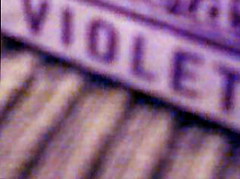Zorro in Hell. Ricardo Montalbán Theatre. 9/6/07.
Culture Clash's Zorro in Hell is part folklore, part history lesson, part political rant, and part stand-up comedy, but it's all extremely entertaining. It draws on traditions of Chicano agit-prop theater (I particularly enjoyed the reference to The Shrunken Head of Pancho Villa) in order to dissect pop culture iconography. Plus, it was a love song to old California with its checkered history of exploitation, oppression, and revolution. While not every line was perfect, the fast-paced wit ensured that I laughed so much my face was sore.
Zorro in Hell is the story of a writer (Richard Montoya) who finds himself in a hotel that serves as a museum of old California with a proprietress (Sharon Lockwood) who claims to have seduced and inspired historical and liteary greats from Joaquin Murrieta to Jack Keroac. She and a cast of very queer characters seek to teach the writer the story of Zorro, taking him from a cynical aspiring screenwirter to a revolutionary in the Zorro mold.
Of course, this plot is only an occasional accessory to witty one-liners and a postmodern exploration of California histoy and Zorro mythology. Culture Clash places Zorro in a geneology of tricksters, thieves, and freedom fighters. While they assert that he's directly descended from the Scarlet Pimpernel and an inspiration for Batman, they also implicitly or explicitly link him to Robin Hood, Joaquin Murrieta, and Hannibal Lecter, and perhaps even Br'er Rabbit. The play explores the character's inauthenticity from pulp fiction roots through children's memorobilia. Zorro represents a long history of white and nonwhite children alike nostalgic for a California history that never really existed, but Zorro in Hell comes to the conclusion that Zorro is a character worth emulating despite his problematic history, because first and foremost, he stands up for the people against an exploitative and authoritarian Gobernador. He's a graffiti artist and a one-man rebellion, a terrorist in the most necessary way. Refreshingly, this play embraced the bi-cultural, the alliance between white, Native American, and Mexican as the basis for chicanismo and as the source of potentially revolutionary alliance. It wasn't a piece about how Zorro wasn't authentic enough but rather about how authenticity becomes irrelevant in the face of oppression.
The play is wonderful and I love it and highly recommend it, but no review of mine would be complete without an analysis of gender issues, and this production had some weird ones. First there was the 200-Year-Old-Woman, who was kind of awesome, really. This weird muse/succubus figure isn't exactly a representation of the female experience (she's more symbol than character), but she was a lusty and fiesty old woman (with an occasional inexplicable Irish accent) and as such was kind of fabulous. Of course, she only had one bit, so it got old by the second act, but that's OK really. The real issue wasn't Culture Clash's problems depicting women (for once) but with homosexuality as the foil to masculinity. Our writer-hero was, until he became Zorro, constantly in danger of being sexually victimized. He was kissed by a gay cowboy (and boy can those Culture Clash guys REALLY not do gay right) and raped by Kyle, his bear therapist (the big furry kind, no the big furry kind that lives in the woods). I know that part of this was a humorous take on the tradition of Zorro (and the Scarlet Pimpernel) masquerading as an effete rich boy to hide his secret identity and a performed resistance to the demasculinization and infintalization of any non-white men, but it was also a disturbing depiction of homophobia as the source of all humor. In this world, only Zorro is really a man and everyone else is lesser, as demonstrated by potential homosexuality.
With that being said, the play is overall much stronger than its homophobia and I enjoyed it thoroughly. It just got extended until September 30th and it is very much worth a trip out to Hollywood to see this wonderful exploration of California mythology lovingly and irreverently exploded on stage. Director Tony Taccone and Culture Clashers Richard Montoya, Herbert Sigüenza, and Ric Salinas have a lot to be proud of in this one, and they're working hard up there on stage. The lease you can do is go see it.
P.S. The show also had the best intermission and post-show soundtracks I ever heard. Seriously. I laughed. I sung along. They were all wonderfully appropriate to the show.
Bridget Jones Mad About the Boy
-
The new Bridget Jones movie is going to do really well: Not only is it
better than it needed to be but it's landing in an anxiety-making context
where peop...
1 week ago

0 comments:
Post a Comment